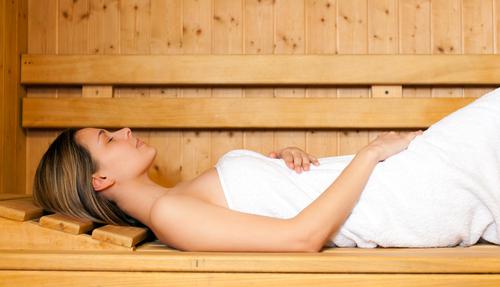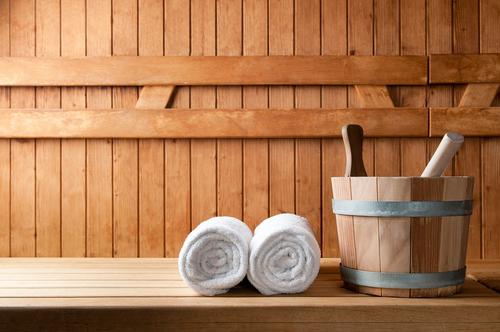Did you know that sweating can be a perfect therapy? If not, then you need to learn how to use a sauna. A sauna is a specially constructed room which can be heated until temperatures between 158 to 212 degrees Fahrenheit (70-100 degrees Celsius). The therapeutic goal in the sauna is to induce heavy sweating, and your skin temperatures can rise to about 104 degrees Fahrenheit (40 degrees Celsius). There are a few different kinds of saunas:
-
Wood burning: where the sauna rocks and the rooms are heated using wood fire.
-
Electrical heated: electrical heaters are used to heat the floor, which then distributes the heat.
-
Infrared room: special light bulbs called "far-infrared sauna bulbs" are used to direct heat waves to a human body.
-
Steam room: moist heat and high humidity are used to heat the room.
How to Use Sauna in a Perfect Way
If you are to reap the full benefits of a sauna, take safety precautions and prepare for your sauna session. A doctor's consultation is always key for a better decision making.
1. Before getting in
- Get hydrated
A sauna experience is accompanied by excessive sweat. This is vital for body toxin elimination. Before getting into a sauna, make sure you have hydrated enough to avoid dehydration. You certainly want to avoid heat stroke caused by dehydration. Drink about four glasses of water or isotonic drink and completely avoid alcohol.

- Dress appropriately
Typically, people strip down in a sauna and lie on a clean towel. Some clothing is accepted, but they should not be tight-fitting. Also, avoid dirty towels and clothes - even the application of body lotions. The temperatures will be high resulting to high perspiration, and you want to avoid dirt or lotion on your skin, which can seep or melt on your skin causing skin pores clogging.
- Read the instructions
Do not assume that the universal sauna instructions and rules apply everywhere. Make sure you read the instructions on how to use a sauna for your particular location.
2. Stay safe inside
- Use a lower temperature
If the temperature feels hotter than you expected, ask for the temperature to be lowered or do it yourself. 158 to 194 degrees Fahrenheit (70-90 degrees Celsius) are the recommended temperature levels.
- Do not stay too long
It might not be surprising, but you should not be inside a sauna for long. 15 minutes is enough to reap health benefits, while any added time can be detrimental to your health.
- Get out immediately if you do not feel well
If you start feeling dizziness, headaches, nausea, or lightheadedness, get out of the sauna immediately. Do not try to prove how tough your endurance can be. Passing out in a sauna can be life-threatening.
3. After getting out
- Cool down slowly
Do not jump into a shower immediately, since this can shock your body. Take about 10 -15 minutes to allow your body to cool down slowly and naturally.
- Re-hydrate
Just like there are instructions to follow before getting into a sauna, follow the recovery rules after the sauna session, too. When inside a sauna, you lose a lot of water through sweating. You need to hydrate again by drinking enough water. This is a must.
- Keep the sauna clean
If the sauna is your personal sauna, clean it using vinegar, baking soda, and other cleaning products. Also, you must vacuum it to keep off dust and dead cells.

Top Health Benefits and Possible Risks of Sauna
When you get into a sauna, there are benefits to reap, but a number of risks attached to it too. That is why you need to consult your doctor for proper advice on how to use a sauna. Here are some issues to discuss with your doctor before you sauna.
1. Health benefits
- Reduce stress level
The sauna temperature causes your skin temperature to rise, your blood circulation to improve, and your muscles to relax. Using a sauna moves your body into a parasympathetic state which helps you reduce your stress level.
- Ease pain
As your blood vessels dilate and blood circulation increases, healing minor bruises, and cuts are noted. Secondly, endorphin hormones are activated, which numbs your body and reduces acne pain along with muscle soreness.
- Improve cardiovascular health
When you are in a sauna, your blood vessels dilate and blood circulation increases. This helps to reduce blood pressure, reducing the risk of a heart attack and stroke. Additionally, when you burn a lot of calories in a sauna you lose weight, which is essential for cardiovascular health.
- May lower risk of Alzheimer's
Alzheimer's disease is the most pronounced form of dementia (cognitive decline). There has been no clear scientific research to confirm that sauna heals Alzheimer's disease, but among those who use the sauna, fewer report Alzheimer's disease cases.
2. Possible risks
- Blood pressure risk
If one happens to get out of a sauna and directly into a cold shower, that switch causes sudden blood pressure rise. This can be fatal, more for those with blood pressure issues than those with no blood pressure issues. Always take time to cool down.
- Dehydration risk
One instruction on how to use a steam room is this: you must rehydrate quickly. If you do not follow this one rule, you are risking dehydration. If you suffer from kidney diseases, you especially should have a doctor's consent before using a sauna to avoid dehydration.
A sauna can be very beneficial if used in the right way and precautions are taken. Besides reading these guidelines, it is essential that you follow sauna instructions and doctors' advice. Lastly, remember that pregnant mothers should not get into a sauna. Always consider your body health status before getting into a sauna.
